With our GreenView® lawn fertilizers and grass seeds, you are receiving the benefit of the same advanced technologies and proprietary ingredients as used on championship golf courses. Our zero phosphate lawn fertilizer line demonstrates our continued environmental commitment. GreenView® offers a full line of fall and spring lawn fertilizers; proprietary grass seeds and seed starting products; weed control, disease and pest control products; and tree, plant and shrub fertilizers to keep your lawn and garden beautiful all year long. Order directly from our online store or find a local retailer near you.

How to fix dead patches in the lawn
Summer is rough on a lawn. Patchy dead spots can come from all sorts of directions, including fungal diseases such as brown patch and rust, animal digging, grub damage, dog urine and plain, old heat and drought. Whatever the cause, late summer through early fall is prime time to patch the patchiness.
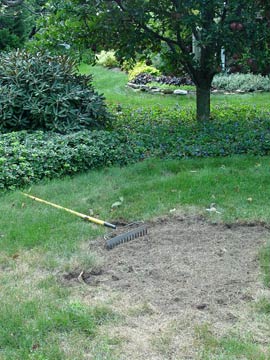
Grubs killed this patch of lawn. The dead turf
has been raked off.
© George Weigel
Grass seed germinates well in those cooler, damper conditions. Then the young roots get off to a good start in soil that's still reasonably warm for growth. Early spring is also a good time to patch, but you'll need to pay more attention to watering as the weather turns hot and dry. Young grass plants are more vulnerable to heat and drought stress than established grass. Especially in hot areas, early-fall lawn-patching is best because that gives young grass 6 or 7 months of potential root growth before hitting its first test in the summer oven.
Here's the process:
- Clear out any dead, matted turf and other debris. Grass will germinate and root best when it comes into contact with soil.
- Loosen the soil. At least scratch the surface, or better yet, dig and loosen the top 2 or 3 inches. If the soil is particularly poor, work in a little compost or similar organic matter. Don't just toss seed on top of hard ground.
- Scatter grass seed over the loosened soil. Choose good-quality seed that's geared for your climate, such as Greenview Fairway Formula Grass Seeds. Lightly scratch in the seed so that some of it is incorporated into the top quarter-inch of the soil and some is at or near the surface. Lightly tamp for good seed/soil contact.
- Fertilize. Get new growth off to a good start by scattering a small amount of lawn fertilizer specially formulated for new grass.
- Mulch and water. Top the patched area with a light layer of straw or chopped leaves – just enough to cover the ground. This helps slow evaporation, discourages seed washouts and improves germination. Water enough to wet the top 2 inches of soil.
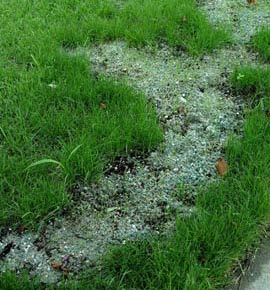
This dead patch has been repaired with an
all-in-one combination of grass seed, starter
fertilizer and paper mulch.
© George Weigel
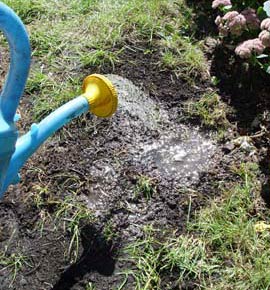
Keep newly patched lawns watered for best
seed germination.
© George Weigel
Streamline the process by using products that take care of two or more of those steps in one. For example, GreenView Grass Seed Accelerator is a starter fertilizer incorporated into bits of paper mulch. It takes care of the fertilizer and mulching steps at the same time.
GreenView Lawn Repair Seed, Mulch and Fertilizer Combinations include the seed, fertilizer and paper mulch all in one product. Those are just scattered over loosened soil, tamped and watered. With both the accelerator and lawn-repair combinations, the paper mulch disintegrates on its own, also saving the step of raking off straw once the grass seed germinates.
No matter how you patch, it's very important to keep the seed bed consistently damp until the seed is up. Dry seeds won't germinate very well at all, and letting the soil go dry after a new grass plant has broken out of its seed coat may kill it before it has a chance to get going.
In hot, dry weather, you'll probably need to dampen the surface once or twice a day. Once the grass grows to about 2 inches tall, reduce watering to once every few days. Begin mowing when the young grass reaches about 4 inches tall. After one full season, your patched area should be as established as the rest of the lawn. By then, you probably won't be able to tell the difference…unless those grubs, dogs and fungi decide to pay another visit.
Roses for noses: What are the most fragrant?
A plant that's covered in skin-piercing thorns and that's prone to attack by more bugs and diseases than most any other plant had better have an astounding redeeming trait to earn its keep in the garden. The rose has at least two – good-looking flowers and some of the best fragrance this side of the cologne counters.
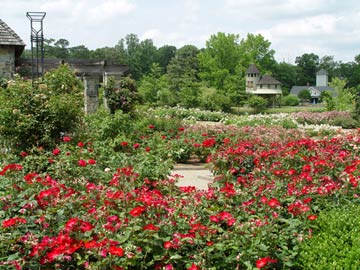
Fragrance and stunning good looks make
up for rose thorns and their propensity for
bug and disease problems.
© George Weigel, taken at Lewis Ginter
Botanical Gardens, Richmond, VA
Roses have more common scents than just about any home-garden plant. That explains why so many gardeners are willing to spray, prune, pamper and suffer regular wounding in order to include a few roses in the landscape.
Most roses have maintained at least fair fragrance, a trait that has been a leading casualty of modern flower breeding. Recent flower production has focused largely on increased flowering, new colors, long bloom time, compact plant size and bug- and disease-resistance. In the effort to deliver as much of that as possible, fragrance has been the odd trait out. Even some roses aren't very fragrant anymore, but so many are that the rose is still a top choice for those interested in fragrant yards.
Rose scent comes from the particular mix of plant oils in each rose variety. As many as 300 different primary oils can show up in a rose. Usually only four or five of them make up the main scent, which is called “base notes” in rosarian lingo. Not everyone agrees on which roses smell the best, though.
Different people have different opinions, and it’s common for different “sniffers” to describe what they smell in different terms. Some of that is due to how our differing olfactory systems assess each rose’s unique blend of plant oils. But research has found that roses can change their scents based on changing environmental factors.
Not all flowers on the same bush smell exactly the same either. Trained noses can pick up these differences. Try it yourself. Next time you’re rose-to-nose, try sniffing multiple flowers. See if you pick up any differences between, say, a rose high on the plant vs. one near the bottom, or a rose on the sunniest side of the plant vs. one on the back side.
One of the biggest differences is the change in scent as a rose flower ages. A newly opened bud may start out smelling fruity but morph more into a clove-like scent as the flower opens and matures. Neither do roses smell the same from year to year. Weather variations account for one significant difference. For example, warmer weather at bud time usually leads to a stronger scent at opening time, and roses tend to hold their scents longer when the weather is humid.
The type of soil and the nutrition in it is another smell-changer. Roses are heavy feeders and perform best when given regular and adequate doses of a fertilizer formulated particularly for them, such as GreenView with GreenSmart Rose Food. Young roses (i.e. the first 2 years in the ground) benefit from three to four applications of this long-acting granular fertilizer per season, starting in spring, while established roses do well with two or three applications, starting in spring.
While most rose fragrance comes from glands at the base of the petals, some also comes from the stamens -- those little pollen-holding projections inside the flower. That's especially true in roses with single or semi-double flowers.
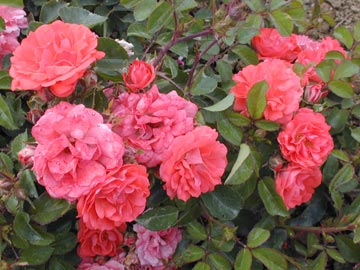
Fragrance and stunning good looks make
up for rose thorns and their propensity for
bug and disease problems.
© George Weigel
So for the best sniffing experience, sniff the stamens as well as around the petal perimeter. One good way to end up with your favorite smellers in your garden is to do some test-sniffs before buying.
That's easy if you're buying when the roses are in bloom, but another option is to visit a public garden. Many of them have rose collections, and that will give you a chance to smell even more choices than may be available at the local garden center.
Or if you trust other people's sniffers more than your own, here are a dozen that have either won American Rose Society fragrance awards or are widely regarded as some of the most fragrant rose varieties:
- ‘Double Delight’ (a pink bicolor hybrid-tea type).
- ‘Mr. Lincoln’ (dark red hybrid tea.
- ‘Fragrant Cloud’ (orange/red hybrid tea).
- ‘Scentimental’ (burgundy and cream striped floribunda type).
- ‘Tiffany’ (pink/yellow blend hybrid tea).
- ‘Angel Face’ (lavender floribunda).
- ‘Chrysler Imperial’ (dark red hybrid tea).
- ‘Fragrant Cloud’ (coral red hybrid tea).
- ‘Sunsprite’ (yellow floribunda).
- ‘Miss All-American Beauty’ (pink hybrid tea).
- ‘Midas Touch’ (gold hybrid tea).
- ‘Honey Perfume’ (apricot/yellow floribunda).
Camellias for colder climates
The camellia has long been a staple of Southeastern and other mild-winter landscapes with its glossy, evergreen foliage and rose-like flowers. Thanks to recent breeding and warmer winters, a surprising number of camellias now are good options in colder American gardens – or at least those where winter lows usually don’t go much below 0 degrees. So-called “hardy camellias” give Northern and Midwestern gardeners a new alternative to azaleas, rhododendrons, mountain laurels and Japanese andromeda.
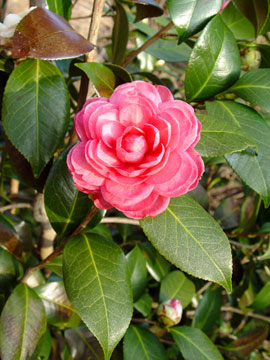
Camellia flowers resemble a rose and
produce some of the showiest flowers
of any shrub.
© George Weigel
As with those broad-leaf evergreens, camellias prefer the same shaded, protected and acid-soil planting conditions. Growing camellias in the North vs. the South involve some important differences.
For starters, variety is important. Not just any camellia can survive winters where it’s common for overnight temperatures to dip into the single digits. Some camellia varieties have been bred and selected for superior cold-hardiness. These are generally the speciesCamellia oleifera, Camellia japonica, Camellia sasanqua and especially hybrids of those.
You'll find cold-hardy camellias that bloom either in late fall or very early spring. That’s a key attraction of camellias in addition to their evergreen foliage and striking flowers…they bloom at a time of year when little else is in color. Fall-blooming hardy camellias are available under such series names as ‘Winter’ and ‘Ashton.’ Early spring bloomers are available under such series names as ‘Spring’ and ‘April.’
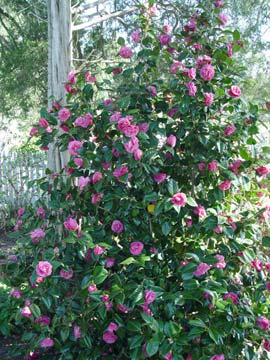
Camellias have long been popular in
warm climates, but cold-hardy types are
now available where winter lows reach
0 degrees.
© George Weigel
One of the best ways to tell if a camellia is winter-hardy in your area is whether local nurseries are selling it. Retailers usually stick with varieties known to be hardy in their particular climates. That doesn’t mean a camellia is doomed if you buy one on the way back from a trip to the South. It just means the survival odds are less.
Another option is to check a variety's winter-hardiness label. Look for varieties that are cold-hardy down to USDA Hardiness Zone 6B – meaning winter lows that bottom out at 0 to minus 5 degrees. Even cold-hardy camellias are iffy in winters much colder than that. But even in Zones 6A or lower, careful siting and a few warm winters in the early years may make camellias possible.
In cold climates, when and where you plant a camellia is more critical than in warmer climates. North and northwest exposures are ideal camellia spots in cooler climates – and in particular, sites that are protected from winds by walls, buildings or a windbreak of tall evergreens. Camellias appreciate this winter shading and protection because it gives them more consistent winter dormancy and prevents cold winter winds from drying their large leaves when the ground is frozen and unable to resupply the roots with moisture.
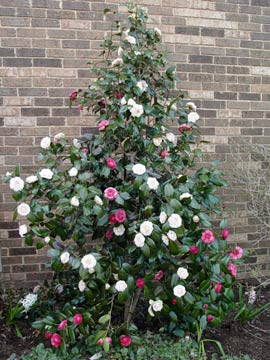
It’s especially important to plant cold-
climate camellias in a wind-protected
area, such as along a wall.
© George Weigel
Research has found that camellias are more susceptible to winter injury when the plants break dormancy due to fluctuating winter temperatures. That can happen not only in open, southern exposures but in eastern exposures when the morning sun suddenly warms a camellia after a cold night.
Camellias also tolerate winter weather better when planted higher on a slope and not in a low-lying “frost pocket” where cold air settles in winter. Spring planting (April and May) is by far better than fall planting in the North. Reason: it gives the young roots more time to establish before the stress of a first winter. Also helpful is wrapping a new camellia in burlap the first winter or two. Pound stakes around the plant and make a cylinder of burlap around it as opposed to letting the fabric touch the plant.
Camellias prefer loose, well drained soil, so work an inch or two of compost, rotted leaves, peat moss or similar organic matter into the existing soil at planting time. All camellias do best in acidy soil as well, so check the pH and add sulfur if the reading isn't 6 or lower.
Use a fertilizer specially formulated for camellias, such as GreenView with GreenSmart Azalea, Camellia and Rhododendron Food, which contains acidifying sulfur as well as a variety of long-acting nutrients that camellias need. For the first three years, scratch fertilizer into the surrounding soil three times a year – early spring, late spring and mid to late fall. Then cut back to twice a year – early spring and mid to late fall.
If you're still infatuated with this Asian-native shrub but live in cold areas that are even beyond the range of cold-hardy camellias, try growing in containers. Camellias do well in containers set outside on decks or patios in summer and then moved into an unheated, bright spot in winter, such as a sun porch or garage with a window.
Fertilize container camellias every 4 to 6 weeks with GreenView with GreenSmart Azalea, Camellia and Rhododendron Food, and keep the soil consistently damp, including with occasional light waterings during winter storage. If the unthinkable happens and you find your camellia leafless at winter's end, don’t give up too soon.
Winter-injured camellias often are still alive at the root level and will push out new growth – sometimes as late as June.
Customers who read this article purchased:
With our GreenView® lawn fertilizers and grass seeds, you are receiving the benefit of the same advanced technologies and proprietary ingredients as used on championship golf courses. Our zero phosphate lawn fertilizer line demonstrates our continued environmental commitment. GreenView® offers a full line of fall and spring lawn fertilizers; proprietarygrass seeds and seed starting products; weed control, disease and pest control products; andtree, plant and shrub fertilizers to keep your lawn and garden beautiful all year long. Order directly from our online store or find a local retailer near you.
About Lebanon Seaboard Corporation
Lebanon Seaboard Corporation is a manufacturer of lawn and garden, wild bird food and professional turf products. Our brands include; Preen, Greenview Fertilizers and Grass Seed, Lyric Wild Bird Food, Lebanon Pro, ProScape and Woodace.
We have manufactured lawn and garden products for the consumer lawn and garden, professional sports turf, landscape and golf course markets since 1947. The company was founded in Lebanon, PA and remains headquartered in the same town 60 years later. Built on a commitment to new product research and development, Lebanon Seaboard continues to introduce advancements in technology through the creation of new product lines that out-perform competitive brands. Our customers span the globe as we provide turf products that are used on the worlds finest championship fairways.
By choosing Greenview Fertilizer and Grass Seeds, you are receiving the benefit of the same advanced technologies as used on championship golf courses. Lebanon Seaboard Corporation has prospered over half a century in an industry constantly challenged by change and competition. We continue to remain resilient and dedicated to the customers we serve. We welcome the opportunity to serve you.
Sincerely,
Katherine Bishop, President, CEO, Chairman
Lebanon Seaboard Corporation